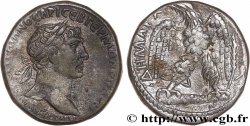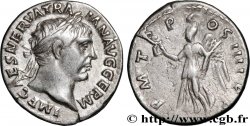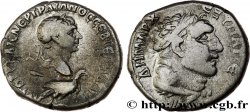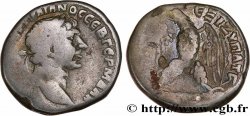bpv_318471 - TRAIANUS Tétradrachme syro-phénicien
Nicht verfügbar.
Artikel auf unserem Online-Shop verkauft (2014)
Preis : 680.00 €
Artikel auf unserem Online-Shop verkauft (2014)
Preis : 680.00 €
Type : Tétradrachme syro-phénicien
Datum: 103-111
Name der Münzstätte / Stadt : Tarse, Cilicie
Metall : Silber
Durchmesser : 26 mm
Stempelstellung : 12 h.
Gewicht : 13,49 g.
Seltenheitsgrad : R1
Kommentare zum Erhaltungszustand:
Haut relief. Remarquable, surface d’origine encore présente, style particulier
N° im Nachschlagewerk :
Pedigree :
Cet exemplaire, qui est le 0754_031 de la base TSP, provient de la vente Gorny d’avril 1989, lot numéro 448
Vorderseite
Beschreibung Vorderseite Tête laurée de Trajan à droite.
Legende des Averses AUTOKR KAIS NER TRAIANOS SEB GERM DAKIK
Übersetzung der Vorderseite (L’empereur César Nerva Trajan Auguste Germanicus Dacique).
Rückseite
Beschreibung Rückseite Tyché tourelée, voilée et drapée assise à droite sur un rocher, tenant une palme de la main droite ; à ses pieds à droite, fleuve aux longs cheveux flottants en mèches nageant à droite.
Legende des Reverses : DHMARC EX UPAT E PP MHTROPPOLEOS/ TAR
Übersetzung der Rückseite (Tribun du Peuple, Consul pour la cinquième fois père de la patrie de la ville ; Tarse, le nom de la ville en monogramme).
Kommentare
Le Prieur 754 se distingue des 755 à 757 par des variantes de légende et d’aspect du dieu-fleuve Cydnus.
Quel fut le motif et la date de cette frappe ?
Elle est postérieure à 102 puisque la légende de revers signale le cinquième consulat qui date de 103, les autres informations de date étant antérieures. Elle est antérieure à 112 où le sixième consulat est décerné.
Nous sommes toujours dans la compétition des frappes entre Tarse et Antioche pour le type à la Tyché, compétition qui va bientôt s’interrompre après Hadrien.
Les comparaisons déjà faites sous Auguste entre le type d’Antioche à la Tyché seraient donc ici encore plus nécessaires si l’on imagine une translation temporaire de la frappe en argent d’une ville à l’autre.
Si nous plaçons ces émissions de Tarse, qui ne sont pas négligeables, entre 103 et 111, il est exact que les émissions d’Antioche, sur cette période, sont inexistantes (les frappes répertoriées représentent un total de dix-sept exemplaires en trois types concentrés sur les années 1 et 2 du règne donc 98 et 99 AD.
Si l’on suit la théorie de Richard McAlee et que l’on affecte les émissions précédemment données à Tyr à Antioche (Prieur 1477 à 1496), seules les dernières, datés du cinquième consulat mais antérieures à 110 AD où les émissions sont désormais datées par années, sont effectivement conséquentes.
Nos émissions à Tarse pourraient-elles être du début du cinquième consulat, donc vers 103, pour décliner ensuite au profit d’Antioche - ou de Tyr - à la fin du cinquième consulat ?
L’identité de Tychés reste flagrante.
Certes, la ville de Tarse était baignée par un fleuve, le Kydnos, certes, elle avait, comme toutes les villes grecques, une déesse locale, une Tyché, mais il faut admettre que la ressemblance entre celle de Tarse et celle d’Antioche est plus que frappante.
Celle d’Antioche étant la représentation d’une statue réelle, dont on connaît l’auteur, Eutychides, et dont une réplique miniature d’époque est encore conservée aujourd’hui au musée du Vatican, la question de savoir quelle ville a copié l’autre ne se pose pas.
Cela nous amène à plusieurs remarques intéressantes.
Tout d’abord, sur un plan économique, la règle qui veut que le modèle le plus connu soit toujours le mieux accepté était déjà parfaitement valide. Tarse copie Antioche parce que le type d’Antioche est le plus répandu. Ensuite, quelque soit le rite religieux qu’exprime la palme dans la main de la Tyché (certainement un attribut amovible, puisque nous connaissons des représentations de cette Tyché avec des épis et du pavot) il est également valide à Tarse et relève donc probablement d’un rituel spécifique aux Tychés.
On note que certains sigma sont gravés en C.
Dans la base TSP maintenue par Michel Prieur, quarante-quatre exemplaires sont maintenant répertoriés, dont un seul en musée, à Oxford. Cette situation atypique s’explique car ce type était rarissime - et donc absent des musées - jusqu’à une trouvaille dispersée au milieu des années 1980, depuis longtemps épuisées mais sans que les musées soient intervenus pour compléter leurs plateaux.
Prior 754 is distinguished from 755 to 757 by variations in the legend and appearance of the river god Cydnus.
What was the reason and date of this strike? It is later than 102 since the reverse legend indicates the fifth consulate which dates from 103, the other date information being earlier. It is prior to 112 where the sixth consulate was awarded.
We are still in the competition of strikes between Tarsus and Antioch for the Tyche type, a competition which will soon be interrupted after Hadrian.
The comparisons already made under Augustus between the Antioch type and the Tyche would therefore be even more necessary here if we imagine a temporary transfer of silver striking from one city to another..
If we place these issues from Tarsus, which are not negligible, between 103 and 111, it is true that the issues from Antioch, over this period, are non-existent (the strikes listed represent a total of seventeen examples in three types concentrated on years 1 and 2 of the reign, therefore 98 and 99 AD.
If we follow Richard McAlee's theory and assign the emissions previously given in Tyre to Antioch (Prior 1477 to 1496), only the last ones, dated to the fifth consulate but prior to 110 AD where the emissions are now dated by years, are actually consistent..
Could our issues in Tarsus be from the beginning of the fifth consulate, therefore around 103, to then decline in favor of Antioch - or Tyre - at the end of the fifth consulate? The identity of Tyches remains obvious..
Certainly, the city of Tarsus was bathed by a river, the Kydnos, certainly, it had, like all Greek cities, a local goddess, a Tyche, but it must be admitted that the resemblance between that of Tarsus and that of Antioch is more than striking.
The one in Antioch being the representation of a real statue, whose author, Eutychides, is known, and of which a miniature replica from the period is still preserved today in the Vatican Museum, the question of which city copied the other does not arise..
This brings us to several interesting observations..
First of all, from an economic point of view, the rule that the best known model is always the most accepted was already perfectly valid.. Tarsus examples Antioch because the Antioch type is the most widespread. Then, whatever religious rite is expressed by the palm in the hand of Tyche (certainly a removable attribute, since we know of representations of this Tyche with ears of corn and poppy) it is also valid in Tarsus and therefore probably relates to a ritual specific to the Tyches.
Note that some sigmas are engraved in C.
In the TSP database maintained by Michel Prieur, forty-four examples are now listed, including only one in a museum, in Oxford.. This atypical situation is explained by the fact that this type was extremely rare - and therefore absent from museums - until a find dispersed in the mid-1980s, long since out of print but without museums having intervened to complete their trays.
Quel fut le motif et la date de cette frappe ?
Elle est postérieure à 102 puisque la légende de revers signale le cinquième consulat qui date de 103, les autres informations de date étant antérieures. Elle est antérieure à 112 où le sixième consulat est décerné.
Nous sommes toujours dans la compétition des frappes entre Tarse et Antioche pour le type à la Tyché, compétition qui va bientôt s’interrompre après Hadrien.
Les comparaisons déjà faites sous Auguste entre le type d’Antioche à la Tyché seraient donc ici encore plus nécessaires si l’on imagine une translation temporaire de la frappe en argent d’une ville à l’autre.
Si nous plaçons ces émissions de Tarse, qui ne sont pas négligeables, entre 103 et 111, il est exact que les émissions d’Antioche, sur cette période, sont inexistantes (les frappes répertoriées représentent un total de dix-sept exemplaires en trois types concentrés sur les années 1 et 2 du règne donc 98 et 99 AD.
Si l’on suit la théorie de Richard McAlee et que l’on affecte les émissions précédemment données à Tyr à Antioche (Prieur 1477 à 1496), seules les dernières, datés du cinquième consulat mais antérieures à 110 AD où les émissions sont désormais datées par années, sont effectivement conséquentes.
Nos émissions à Tarse pourraient-elles être du début du cinquième consulat, donc vers 103, pour décliner ensuite au profit d’Antioche - ou de Tyr - à la fin du cinquième consulat ?
L’identité de Tychés reste flagrante.
Certes, la ville de Tarse était baignée par un fleuve, le Kydnos, certes, elle avait, comme toutes les villes grecques, une déesse locale, une Tyché, mais il faut admettre que la ressemblance entre celle de Tarse et celle d’Antioche est plus que frappante.
Celle d’Antioche étant la représentation d’une statue réelle, dont on connaît l’auteur, Eutychides, et dont une réplique miniature d’époque est encore conservée aujourd’hui au musée du Vatican, la question de savoir quelle ville a copié l’autre ne se pose pas.
Cela nous amène à plusieurs remarques intéressantes.
Tout d’abord, sur un plan économique, la règle qui veut que le modèle le plus connu soit toujours le mieux accepté était déjà parfaitement valide. Tarse copie Antioche parce que le type d’Antioche est le plus répandu. Ensuite, quelque soit le rite religieux qu’exprime la palme dans la main de la Tyché (certainement un attribut amovible, puisque nous connaissons des représentations de cette Tyché avec des épis et du pavot) il est également valide à Tarse et relève donc probablement d’un rituel spécifique aux Tychés.
On note que certains sigma sont gravés en C.
Dans la base TSP maintenue par Michel Prieur, quarante-quatre exemplaires sont maintenant répertoriés, dont un seul en musée, à Oxford. Cette situation atypique s’explique car ce type était rarissime - et donc absent des musées - jusqu’à une trouvaille dispersée au milieu des années 1980, depuis longtemps épuisées mais sans que les musées soient intervenus pour compléter leurs plateaux.
Prior 754 is distinguished from 755 to 757 by variations in the legend and appearance of the river god Cydnus.
What was the reason and date of this strike? It is later than 102 since the reverse legend indicates the fifth consulate which dates from 103, the other date information being earlier. It is prior to 112 where the sixth consulate was awarded.
We are still in the competition of strikes between Tarsus and Antioch for the Tyche type, a competition which will soon be interrupted after Hadrian.
The comparisons already made under Augustus between the Antioch type and the Tyche would therefore be even more necessary here if we imagine a temporary transfer of silver striking from one city to another..
If we place these issues from Tarsus, which are not negligible, between 103 and 111, it is true that the issues from Antioch, over this period, are non-existent (the strikes listed represent a total of seventeen examples in three types concentrated on years 1 and 2 of the reign, therefore 98 and 99 AD.
If we follow Richard McAlee's theory and assign the emissions previously given in Tyre to Antioch (Prior 1477 to 1496), only the last ones, dated to the fifth consulate but prior to 110 AD where the emissions are now dated by years, are actually consistent..
Could our issues in Tarsus be from the beginning of the fifth consulate, therefore around 103, to then decline in favor of Antioch - or Tyre - at the end of the fifth consulate? The identity of Tyches remains obvious..
Certainly, the city of Tarsus was bathed by a river, the Kydnos, certainly, it had, like all Greek cities, a local goddess, a Tyche, but it must be admitted that the resemblance between that of Tarsus and that of Antioch is more than striking.
The one in Antioch being the representation of a real statue, whose author, Eutychides, is known, and of which a miniature replica from the period is still preserved today in the Vatican Museum, the question of which city copied the other does not arise..
This brings us to several interesting observations..
First of all, from an economic point of view, the rule that the best known model is always the most accepted was already perfectly valid.. Tarsus examples Antioch because the Antioch type is the most widespread. Then, whatever religious rite is expressed by the palm in the hand of Tyche (certainly a removable attribute, since we know of representations of this Tyche with ears of corn and poppy) it is also valid in Tarsus and therefore probably relates to a ritual specific to the Tyches.
Note that some sigmas are engraved in C.
In the TSP database maintained by Michel Prieur, forty-four examples are now listed, including only one in a museum, in Oxford.. This atypical situation is explained by the fact that this type was extremely rare - and therefore absent from museums - until a find dispersed in the mid-1980s, long since out of print but without museums having intervened to complete their trays.







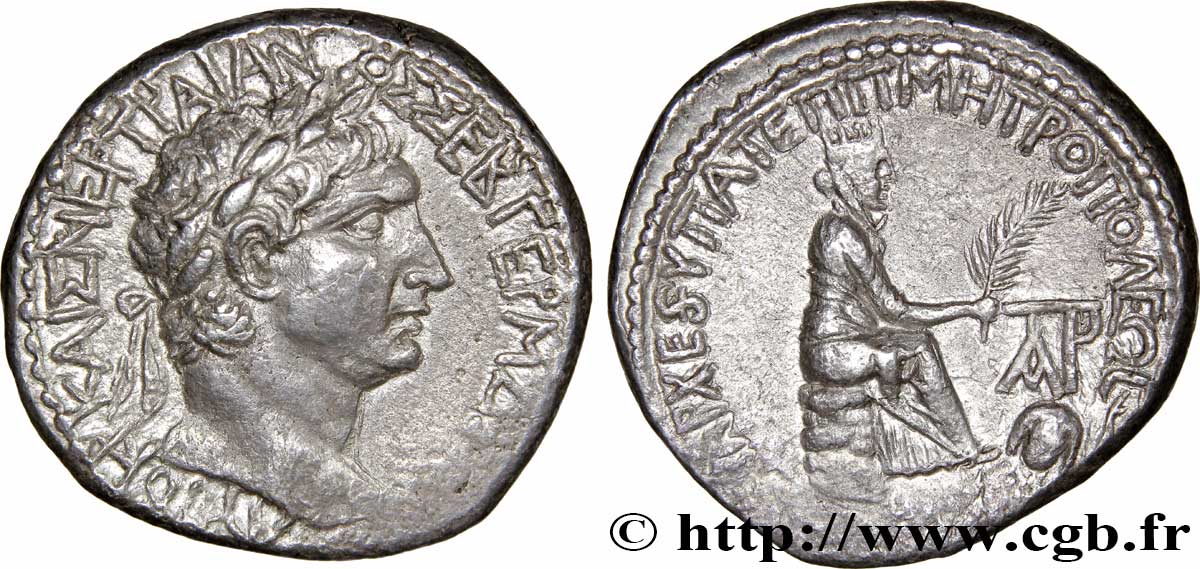
 Berichten über einen Fehler
Berichten über einen Fehler Die Seite drucken
Die Seite drucken Teilen meiner Auswahl
Teilen meiner Auswahl Stellen Sie eine Frage
Stellen Sie eine Frage Einlieferung/Verkauf
Einlieferung/Verkauf
 Details
Details